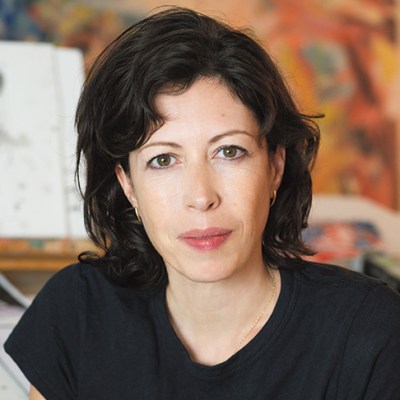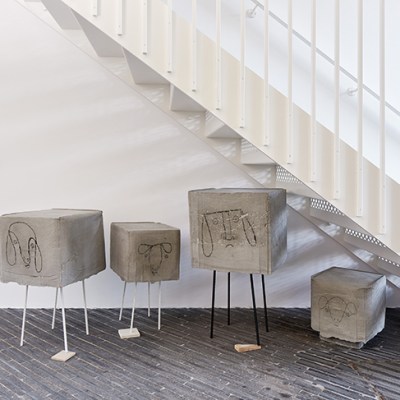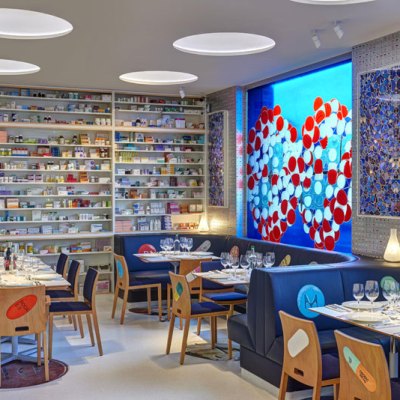Sarah Lucas has never been one to leave an audience indifferent. Back in the 1990s, she earned a reputation as the gobbiest of her contemporaries, an artist who out-swore, out-smoked and out-grossed even her pal Damien Hirst. Pitching her modus operandi somewhere between the more disturbing end of Surrealism and the letters page of Viz magazine, she became known for creating tabloid-baiting work that combined raw sexuality and a brash, punkish DIY aesthetic with the kind of facetiousness rarely voiced by anyone above the age of 15. There were nude photos of the artist astride a filthy toilet; an installation involving two fried eggs and a greasy kebab, laid out on a table in an anatomical arrangement; and Sausage Film (1990), a video in which she cut up and devoured a particularly phallic andouillette, barely stifling her giggles as she chewed. With each new project, she seemed to be challenging herself to create something more offensive than the last, gleefully transgressing both societal mores and modernist good taste. If there was a single message to take home from her art, it was that she was never going to lose much sleep over her own legacy.
Nevertheless, even erstwhile YBAs can become respectable if they last long enough. These one-time outrage merchants are becoming institutionalised via career-spanning retrospectives at international museums, allowing us to get some perspective on whether or not their work stands up when shorn of the hype and patter that defined it the first time round. The great surprise is that Lucas, now the subject of a show at the New Museum in New York, acquits herself rather a lot more convincingly than many of her supposedly more cerebral contemporaries.
Great Dates (1992), Sarah Lucas. Courtesy Sadie Coles HQ, London; © Sarah Lucas
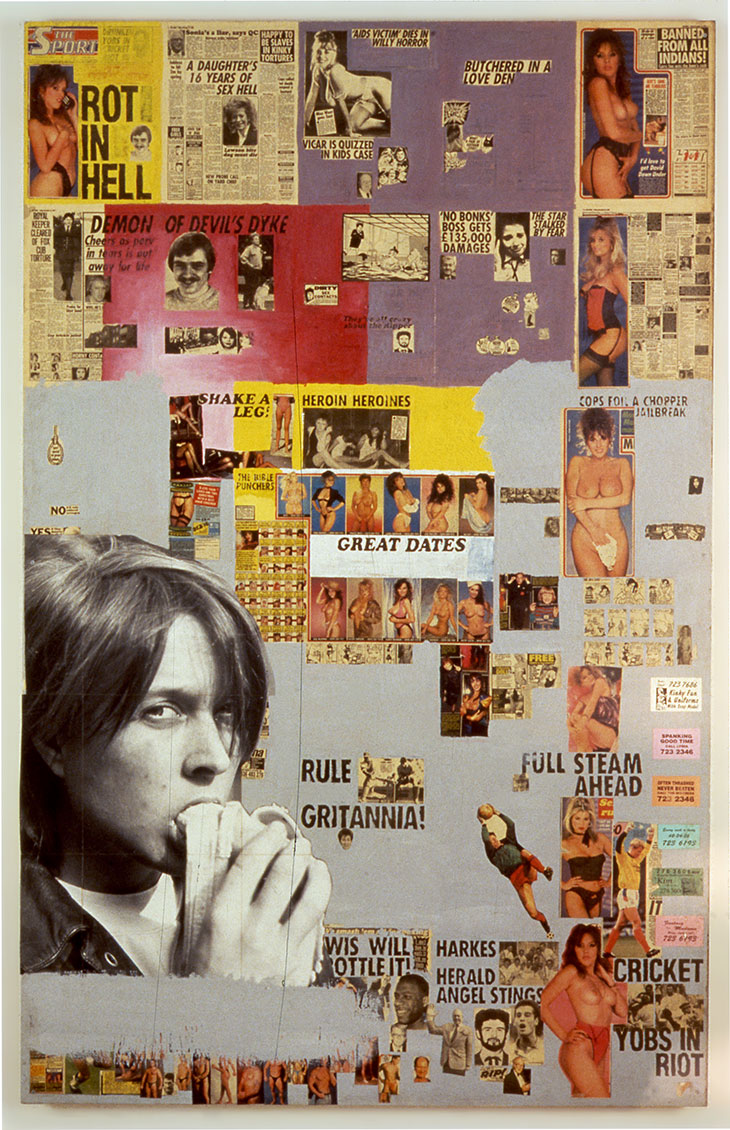
This is not to say that she’s toned anything down. Her work has always dealt with overtly sexual imagery and the ways in which we consume it: her first solo exhibition at Keith Coventry’s City Racing gallery in 1991 (recreated in part here) involved massive blow-ups of pages from the notoriously smutty British tabloid The Sunday Star; another early collage on view at the New Museum, Great Dates (1992), incorporates snippets from lewd flyers found papering the interiors of London phone boxes. Yet if these works hinted at pornography, Lucas’s more recent adventures are uncomfortably close to being the real thing.
Consider Egg Massage (2015), captured at a party held on New Year’s Eve by the gallerist Sadie Coles. The film gives us a close-up view of Lucas’s boyfriend, Julian Simmons, who is lying prone and naked on Coles’s kitchen table as the artist cracks raw eggs over his body, causing yellow slime to ooze over his features until his buttocks are a cascading Niagara of glistening yoke. Lucas then grabs his testicles and, in an agonisingly drawn-out process, manipulates them until they turn an alarming shade of black. Everyone caught on camera seems to be having the time of their life, yet it’s impossible to watch without feeling just a little uncomfortable. You can’t help but admire Lucas for having managed to persistently ramp up the grotesquerie – while simultaneously appearing to have a lot of fun. Indeed, if this show proves anything, it is that times may have changed but Lucas hasn’t particularly.
This is very much in her favour. In the wake of fourth-wave feminism, people are starting to interpret her work in a different light. Where once she might have been seen as a foul-mouthed ‘ladette’ hell bent on causing controversy, it’s now fashionable to see her as a trailblazer, and the wall texts at the New Museum do their best to examine her art through a very of-the-moment prism: Lucas, we’re told, was ‘[subverting] traditional notions of gender, sexuality and identity’ and ‘[pushing] against traditional gender signifiers’ long before such things came to dominate the cultural agenda. It’s a persuasive argument. In her well-known photographic self-portraits, for example, she adopts knowingly androgynous poses, doing her best James Dean impersonation as she eats a banana, or looking up at us confrontationally from a chair, her macho posture rendered faintly comical by the pair of fried eggs slapped over her breasts. Yet to interpret Lucas’s art as a post-#MeToo critique is to condemn it to the level of pseudo-profundity; it ignores the visual gut punches of her best work, the mood of absurdist comedy that gives it such anarchic thrill.
Self-portrait with Fried Eggs (1996), Sarah Lucas. Courtesy Sadie Coles HQ, London; © Sarah Lucas
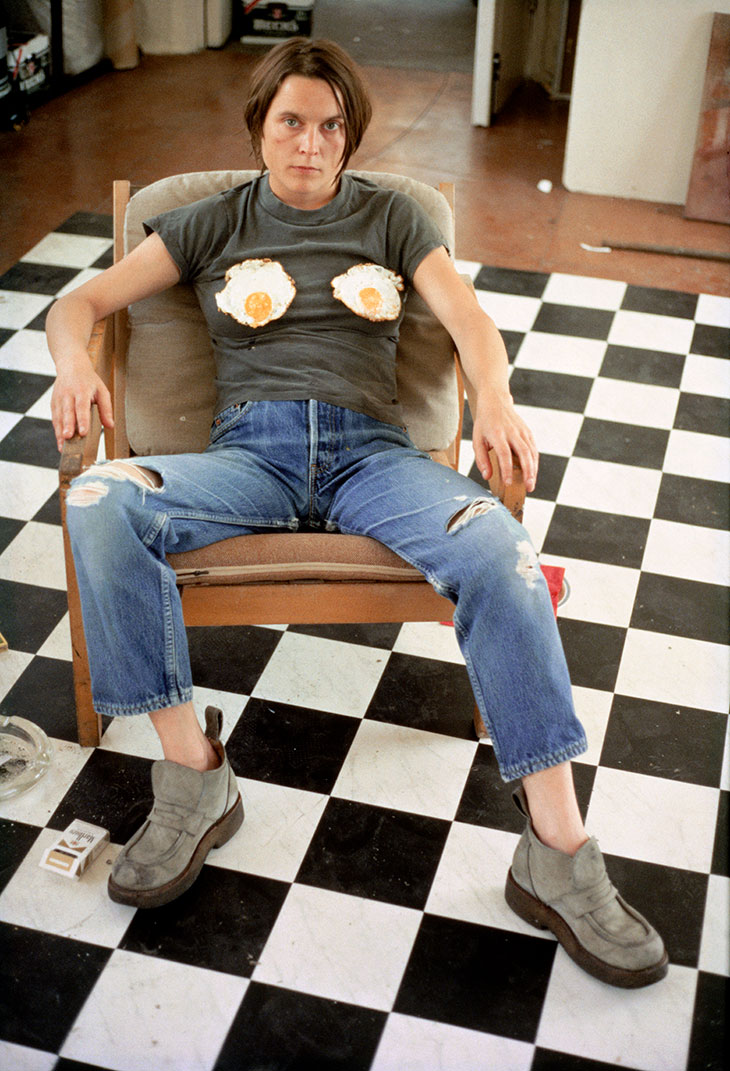
Thankfully, Lucas herself won’t stand for it. In a series of ‘alternative’ captions displayed alongside the rather joyless museum texts, she provides her own, markedly more irreverent, commentary on the exhibits. Simmons, we learn, ‘loves having his knob cast’ (thank goodness for that). ‘Our studio had a toilet outside at the top of the stairs, one that had been there for donkey’s years,’ she writes of the space she shared with the late Angus Fairhurst. ‘It had seen a lot of action and certainly wasn’t picturesque.’ Most tellingly, discussing the banana portrait, she warns that ‘earnestness and hard work are to be regarded with suspicion’.
It’s an informative piece of advice, helping to explain why, for every two successful pieces here, Lucas feels comfortable throwing in an inarguable miss. Certainly, there are some thumpingly crass exhibits here: witness Christ You Know It Ain’t Easy (2000), consisting of a Beatles-quoting title and a recreation of the Crucifixion fashioned from unsmoked Marlboro Reds. (Why not include her account of a real crucifixion, when in 2000 she and Dennis Morris travelled to the Philippines to film her friend Sebastian Horsley suffering on a cross as part of a ‘rebirth ceremony’?) Worse still is Unknown Soldier, a spectacularly stupid response to the invasion of Iraq in 2003. A pair of concrete boots and a neon tube propped against a wall do not make for insightful comment on geopolitical conflict.
Christ You Know It Ain’t Easy (2003), Sarah Lucas. Courtesy Sadie Coles HQ, London; © Sarah Lucas
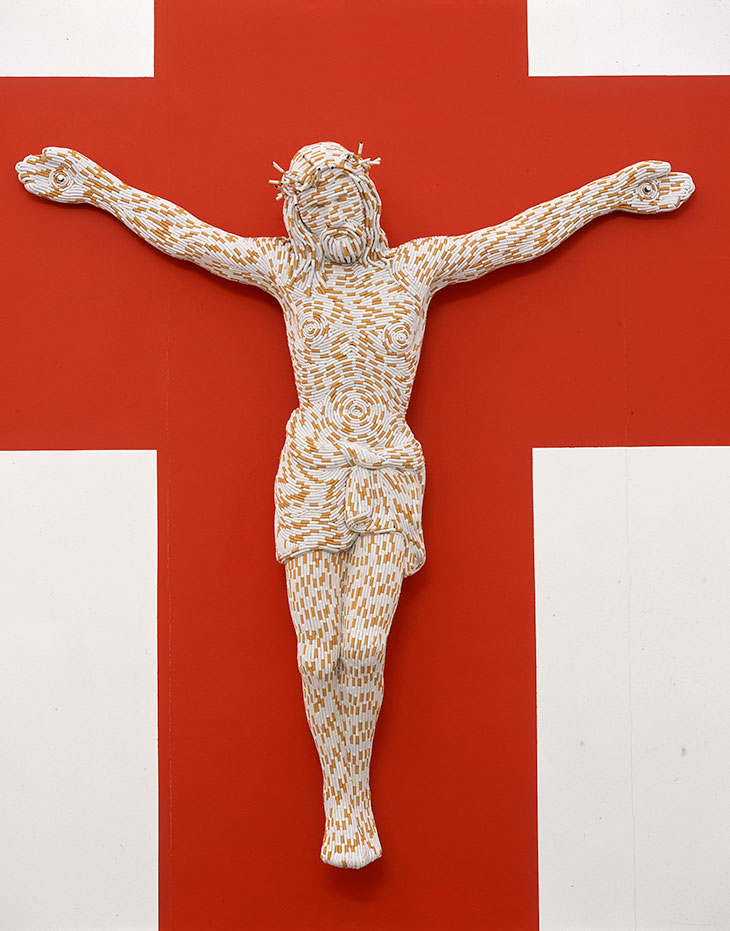
These misfires, however, only serve to illustrate quite how exuberant Lucas’s work can be when she gets it right. Prime examples are a recreation of her turn representing the UK at the Venice Biennale in 2015; a vastly enlarged reproduction of her squirm-inducing photo Chicken Knickers (1997); and a tremendous, spooky display of inadvertently suggestive objets trouvés and white plaster penis casts that matches her signature motifs with the cod-pagan aesthetic of modern British artists like Roger Ackling or William Turnbull.
The greatest surprise here is quite how fresh Lucas’s approach to making art seems. At times, you can get the impression that she represents the missing art-historical link between Louise Bourgeois and a younger generation of artists, including Laure Prouvost, Pauline Curnier Jardin and Michael Dean. Yet what separates her from the rest of the pack, I left thinking, is her seemingly effortless ability to create art that teeters between high seriousness and total inanity. You can read into her work all you like – it contains no shortage of signifiers that hint at psychoanalytical resonance and societal commentary – but sometimes, as she would doubtless tell you, a knob gag really is just a knob gag.
‘Sarah Lucas: Au Naturel’ is at the New Museum, New York until 20 January 2019.

